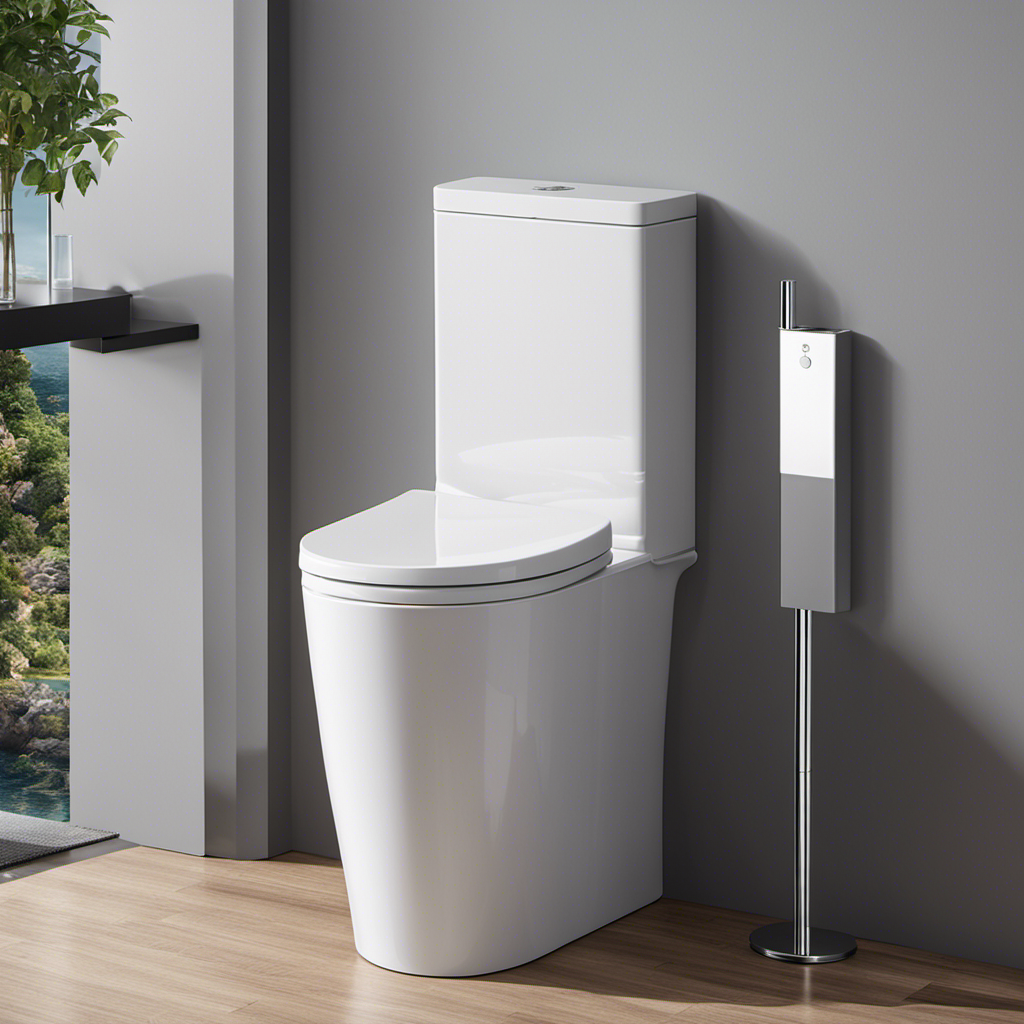Toilet weight, a topic teeming with technicalities and tidbits, tantalizes the curious mind. Today, we delve into the depths of this weighty matter, exploring the factors, types, and considerations that come into play.
From the sturdy floor-mounted behemoths, weighing in at 60 to 130 pounds, to the sleek wall-hung options, tipping the scales at 50 to 70 pounds, we shall unravel the mysteries of toilet weight.
So, dear reader, prepare to be enlightened as we embark on this fascinating journey into the realm of commode heft.
Key Takeaways
- The weight of a toilet is influenced by factors such as the type of toilet, make and model, and material composition.
- Two-piece toilets are lighter and easier to install compared to one-piece and wall-hung toilets.
- The weight of a floor-mounted toilet can range from 60 to 130 pounds, excluding water, lid, and seat.
- Additional fixtures and custom-made tanks can increase the weight of a toilet by 5 to 10 pounds.
Toilet Weight Ranges
The average weight of a floor-mounted toilet ranges from 60 to 130 pounds. Two-piece toilets typically weigh between 60 to 110 pounds. When considering toilet weight, it is important to understand the distribution and factors that contribute to it.
The weight of the toilet can vary depending on the type of toilet, such as one-piece or wall-hung. One-piece toilets generally weigh around 85 to 90 pounds on average, while wall-hung toilets weigh about 50 to 70 pounds.
The weight of a toilet can also be influenced by additional fixtures or custom-made tanks, which can add an extra 5 to 10 pounds. It is worth noting that the standard weight of a toilet does not include the weight of water, lid, and seat, which can add an additional 20 pounds after installation.
The tank of a toilet typically accounts for about one-third of the total weight and is lighter than the bowl. Overall, the weight of a toilet is determined by various factors, such as the type of toilet, additional accessories, and the presence of water.
Factors Affecting Toilet Weight
Wall-mounted toilets are generally lighter compared to floor-mounted ones. The weight variation of toilets can be influenced by various factors. Two-piece toilets, which are more common, tend to be lighter than one-piece toilets. The weight of a toilet can also vary based on its make, model, and material. Additionally, the inclusion of additional fixtures or custom-made tanks can add 5 to 10 pounds to the overall weight.
It is important to note that the standard weight of a toilet does not include the water, lid, and seat, which can add an additional 20 pounds after installation. Furthermore, the tank accounts for about one-third of the total weight, and it is typically lighter than the bowl.
Additional Toilet Weight Considerations
One key aspect to keep in mind when installing a toilet is the weight of additional fixtures or custom-made tanks. The weight distribution of a toilet is influenced by various factors.
The standard weight of a toilet does not include water, lid, and seat, which adds an additional 20 pounds after installation. The tank, which accounts for about one-third of the total weight, is lighter than the bowl. It is important to consider the impact of water and accessories on the overall weight.
Additional fixtures or custom-made tanks can add 5 to 10 pounds to the toilet’s weight. It is essential to take these considerations into account to ensure proper installation and stability of the toilet.
Characteristics of Two-Piece Toilets
Two-piece toilets, which are lighter and more common, typically weigh around 60 pounds according to most online sources. These toilets have several characteristics that make them convenient for installation and shipping:
-
Easy Installation: Two-piece toilets are designed to be easily installed by homeowners or professionals. The separate tank and bowl can be quickly assembled and connected to the plumbing system.
-
Shipping Convenience: Due to their lighter weight, two-piece toilets are easier to ship and handle compared to heavier one-piece or wall-hung toilets. This makes them a popular choice for retailers and online sellers.
-
Lower Risk of Damage: The separate tank and bowl of two-piece toilets reduce the risk of damage during transit. If one component is damaged, it can be replaced individually without having to replace the entire toilet.
-
Versatility: Two-piece toilets come in a variety of styles and designs, offering homeowners more options to match their bathroom decor. The ease of installation and shipping convenience make them a practical choice for many households.
Characteristics of One-Piece and Wall-Hung Toilets
Most online sources indicate that one-piece toilets tend to be heavier than their two-piece counterparts, making them less portable and more expensive. The installation process for one-piece toilets is generally more complex compared to floor-mounted toilets.
One-piece toilets come as a single unit, with the tank and bowl already put together. This means that the entire unit needs to be lifted and positioned onto the floor flange during installation. In contrast, two-piece toilets have separate tanks and bowls, which can be easily assembled and positioned onto the floor flange.
Additionally, one-piece toilets often require professional installation due to their heavier weight and more intricate design. This added complexity and requirement for professional installation contribute to their higher cost as compared to two-piece toilets.
Average Weight of a Floor-Mounted Toilet
Floor-mounted toilets, on average, weigh between 60 to 130 pounds. Here are some key factors and considerations about the weight of floor-mounted toilets:
-
Range of weights: Floor-mounted toilets can vary in weight, with the average falling between 60 to 130 pounds.
-
Impact of additional fixtures: The weight of a floor-mounted toilet can be influenced by the inclusion of additional fixtures or custom-made tanks, which can add an extra 5 to 10 pounds.
-
Make, model, and material: The weight of a floor-mounted toilet can also vary based on the specific make, model, and material used in its construction.
-
Excluded components: It’s important to note that the standard toilet weight does not include the weight of water, lid, and seat. After installation, an additional 20 pounds is typically added.
Understanding the weight of floor-mounted toilets is crucial for proper installation and maintenance.
Typical Weight Range for Two-Piece Toilets
The weight of a standard two-piece toilet can vary depending on various factors such as the make, model, and material used. When it comes to the weight range of two-piece toilets, the average weight falls between 60 to 110 pounds. However, it is important to note that this is just an average and the actual weight can still vary within this range. To provide a clearer understanding, here is a table showcasing the weight ranges for different types of toilets:
| Toilet Type | Average Weight Range (in pounds) |
|---|---|
| Floor-Mounted | 60-130 |
| Two-Piece | 60-110 |
| One-Piece | 85-90 |
| Wall-Hung | 50-70 |
It is also worth mentioning that the weight of a standard toilet does not include the water, lid, and seat. After installation, an additional 20 pounds is typically added. Furthermore, the tank accounts for about one-third of the total weight, and it is usually lighter than the bowl.
Weight Variation Based on Make, Model, and Material
When considering the weight of a standard toilet, variation can be observed based on the make, model, and material used. Understanding the weight variation factors is crucial in choosing the right toilet for your bathroom.
Here are four key points to consider:
-
Material Composition: The weight of a toilet can be influenced by the materials used in its construction. For example, toilets made of ceramic tend to be heavier compared to those made of plastic or composite materials.
-
Design and Structure: The make and model of a toilet can also impact its weight. One-piece toilets, for instance, are generally heavier than two-piece toilets due to their integrated design.
-
Flushing Mechanism: The type of flushing mechanism can affect the weight of a toilet. Toilets with pressure-assisted flushing systems might weigh more than those with gravity-fed systems.
-
Additional Features: Some toilets come with additional features like bidet attachments or custom-made tanks. These extras can add weight to the overall toilet assembly.
Additional Fixtures and Custom-Made Tanks’ Impact on Weight
Adding extra fixtures or customized tanks can increase the overall weight of the toilet. The weight of a toilet can vary based on several factors, including the type of toilet and the materials used.
Two-piece toilets are generally lighter and more common, weighing around 60 to 110 pounds. One-piece toilets, on the other hand, are heavier, weighing about 85 to 90 pounds on average. Wall-hung toilets are the lightest, weighing about 50 to 70 pounds.
However, when additional fixtures or custom-made tanks are added, the weight can increase by 5 to 10 pounds. It is important to consider the weight of the toilet, as well as the weight capacity of the bathroom floor, when installing these fixtures.
Frequently Asked Questions
How Much Does a Wall-Hung Toilet Weigh on Average?
On average, a wall-hung toilet weighs about 50 to 70 pounds. However, it is important to note that the weight can vary depending on the make, model, and material used.
What Is the Weight Range for a One-Piece Toilet?
The weight range for a one-piece toilet can vary depending on factors such as make, model, and material. Common misconceptions about toilet weight include not accounting for the additional weight of the water, lid, and seat.
Do All Toilets Have the Same Weight After Installation?
Toilet weight varies after installation due to factors like toilet weight distribution and the impact of plumbing connections. Not all toilets have the same weight, as it depends on the make, model, and additional fixtures.
Are There Any Factors Other Than Make, Model, and Material That Can Affect the Weight of a Toilet?
Factors such as design, installation, and additional fixtures can impact the weight of a toilet. These factors, along with the make, model, and material, are important considerations when discussing toilet weight.
How Does the Weight of a Toilet Tank Compare to the Weight of the Bowl?
The weight of a toilet tank is typically lighter compared to the weight of the bowl. Toilet weight distribution varies depending on factors such as make, model, and material.
Conclusion
In conclusion, the weight of a toilet is not something to be taken lightly. It may seem like a mundane aspect, but it plays a crucial role in the functionality and durability of the fixture.
The range of toilet weights varies significantly depending on factors such as the type, make, and material used. While two-piece toilets offer a lighter and more common option, one-piece toilets and wall-hung toilets have their own unique characteristics and considerations.
Ultimately, understanding the weight of a toilet allows for informed decision-making when it comes to installation, maintenance, and overall usage.










